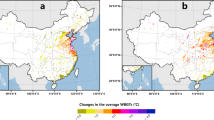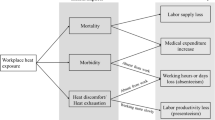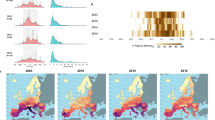Abstract
Extreme heat is already occurring more frequently and with greater intensity, with this trend predicted to continue. Exposure to extreme heat causes labor supply declines, but studies to quantify the economic effects from future climate changes are limited. In this study, we adopt two different exposure-response functions relating extreme heat to the loss of labor working minutes or labor productivity. We estimate that temperature differences between 2006 and 2016 relative to 1980–1990 led to labor losses of ~$1.7 billion annually in the USA. Under the high emissions RCP8.5 scenario, approximately 1–1.8 billion workforce hours will be lost annually in the 2050s, and 1.5–4.4 billion hours will be lost by the 2100s, depending on the exposure-response function used. The lost hours lead to an estimated $51–119 billion in losses by the 2100s, without considering future climate adaptation, demographic, employment, wage structure, or economic changes. Whereas 2006–2016 losses correspond to 0.07% of the 2016 GDP, the 2100s losses rise roughly fourfold to 0.3%, which are mainly caused by the increases of extreme heat conditions with population growth a secondary factor. With the climate change mitigation strategies of the RCP4.5 scenario, 600–2600 million hours of lost labor per year could be avoided in the 2100s, saving $20–78 billion depending on the chosen exposure-response function. We also evaluated the effect of decarbonizing the energy sector in a manner consistent with the 1.5 °C target of the Paris Agreement, finding that these lead to ~77 million avoided lost work hours worth ~$2.5 billion annually by the 2050s with global collaboration but insignificant impacts with US action alone. Though uncertainties and limitations exist in the study, we find that extreme heat will cause large economic losses to US businesses, especially in southern states (from California to Florida), though widespread climate change mitigation has the potential to substantially reduce these losses. We find that uncertainties among the exposure-response functions used to derive the economic effects of extreme heat on labor are much larger than those from the climate models. Previous studies using only one exposure-response function may exhibit substantial biases and likely underestimate uncertainties associated with the effect of climate changes on labor.



Similar content being viewed by others
Data availability
The historical daily maximum temperature was downloaded from NOAA Climate Prediction Center (CPC, https://www.esrl.noaa.gov/psd/data/gridded/data.cpc.globaltemp.html, accessed April 9, 2019). The bias-corrected future daily temperature from CMIP5 simulations was downloaded from the Inter-Sectoral Impact Model Intercomparison Project (ISIMIP2b, https://www.isimip.org/, accessed Jan 9, 2019). The county-level annual employment (working ages 15–64 years old) and annual average weekly wages are from the Quarterly Census of Employment and Wages, US Bureau of Labor Statistics (https://www.bls.gov/cew/datatoc.htm,accessed Jan 10, 2019). The county-level population projections for the USA from ICLUS are downloaded from https://www.epa.gov/gcx/about-gcx-iclus-tool. The NASA GISS ModelE2 is available at https://www.giss.nasa.gov/tools/modelE/.
References
Bentsen M, Bethke I, Debernard JB, Iversen T, Kirkevåg A, Seland Ø et al (2013) The Norwegian earth system model, NorESM1-M – part 1: description and basic evaluation of the physical climate. Geosci Model Dev 6(3):687–720
Burnett R, Chen H, Szyszkowicz M et al (2018) Global estimates of mortality associated with long-term exposure to outdoor fine particulate matter. Proc Natl Acad Sci U S A 115:9592–9597. https://doi.org/10.1073/pnas.1803222115
Chavaillaz Y, Roy P, Partanen AI, Da Silva L, Bresson É, Mengis N et al (2019) Exposure to excessive heat and impacts on labour productivity linked to cumulative CO2 emissions. Sci Rep 9(1):1–11. https://doi.org/10.1038/s41598-019-50047-w
Deser, C., Knutti, R., Solomon, S., & Phillips, A. S. (2012). Communication of the role of natural variability in future north American climate. Nat. Clim. Chang, 2(October)
Dunne JP, John JG, Shevliakova S, Stouffer RJ, Krasting JP, Malyshev SL et al (2013) GFDL’s ESM2 global coupled climate-carbon earth system models. Part II: carbon system formulation and baseline simulation characteristics. J Clim 26(7):2247–2267
Dunne JP, John JG, Adcroft AJ, Griffies SM, Hallberg RW, Shevliakova E et al (2012) GFDL’s ESM2 global coupled climate-carbon earth system models. Part I: physical formulation and baseline simulation characteristics. J Clim 25(19):6646–6665. https://doi.org/10.1175/JCLI-D-11-00560.1
Frieler, K., Lange, S., Piontek, F., Reyer, C. P. O., Schewe, J., Warszawski, L., et al. (2017). Assessing the impacts of 1.5 ° C global warming – simulation protocol of the Inter-Sectoral Impact Model Intercomparison Project ( ISIMIP2b ). Geosci. Model Dev., 10, 4321–4345. https://doi.org/10.5194/gmd-10-4321-2017
Graff Zivin J, Neidell M (2014) Temperature and the allocation of time: implications for climate change. J Labor Econ 32(1):1–26. https://doi.org/10.1086/671766
Haines A, Ebi K (2019) The imperative for climate action to protect health. N Engl J Med 380(3):263–273
Hempel S, Frieler K, Warszawski L et al (2013) A trend-preserving bias correction—the ISIMIP approach. Earth Syst Dyn 4:219–236. https://doi.org/10.5194/esd-4-219-2013
Hsiang S, Kopp R, Jina A, Hsiang S, Kopp R, Jina A et al (2017) Estimating economic damage from climate change in the United States. Science 356(6345):1362–1369
International Energy Agency (IEA), Energy technology perspectives 2012 - pathways to a clean energy system, OECD/IEA, Paris; http://www.iea.org/Textbase/nptoc/etp2012toc.pdf
International Institute of Applied Systems Analysis (IIASA) ECLIPSE v5a data, http://www.iiasa.ac.at/web/home/research/researchPrograms/air/Global_emissions.html; accessed July 2017
Iversen T, Bentsen M, Bethke I, Debernard JB, Kirkevåg A, Seland Ø et al (2013) The Norwegian earth system model, NorESM1-M – part 2: climate response and scenario projections. Geosci Model Dev 6(2):389–415
Jin X, Fiore AM, Civerolo K, et al (2019) Comparison of multiple PM2.5 exposure products for estimating health benefits of emission controls over New York State, USA. Environ Res Lett 14:84023. https://doi.org/10.1088/1748-9326/ab2dcb
Jones CD, Hughes JK, Bellouin N, Hardiman SC, Jones GS, Knight J et al (2011) The HadGEM2-ES implementation of CMIP5 centennial simulations. Geosci Model Dev 4(3):543–570
Kelley, M., Schmidt, G. A., Nazarenko, L. S., Bauer, S. E., Ruedy, R., Russell, G. L., et al. (2020). GISS-E2.1: configurations and climatology. J Adv Model EarthSyst, 12, e2019MS002025. https://doi.org/10.1029/2019MS002025
Kjellstrom T, Briggs D, Freyberg C, Lemke B, Otto M, Hyatt O (2016) Heat, human performance, and occupational health: a key issue for the assessment of global climate change impacts. Annu Rev Public Health 37:97–112. https://doi.org/10.1146/annurev-publhealth-032315-021740
Knittel N, Jury MW, Bednar-Friedl B, Bachner G, Steiner AK (2020) A global analysis of heat-related labour productivity losses under climate change—implications for Germany’s foreign trade. Clim Chang 160(2):251–269. https://doi.org/10.1007/s10584-020-02661-1
Lange S (2018) Bias correction of shortwave and longwave radiation for the EMEMBI dataset. Earth Syst Dynam 9:627–645
Martinich J, Crimmins A (2019) Climate damages and adaptation potential across diverse sectors of the United States. Nat Clim Chang 9(5):397–404
Mignot J, Bony S (2013) Presentation and analysis of the IPSL and CNRM climate models used in CMIP5. Clim Dyn 40(9–10):2089
Giani P, Anav A, De Marco A et al (2020) Exploring sources of uncertainty in premature mortality estimates from fine particulate matter: the case of China. Environ Res Lett 15. https://doi.org/10.1088/1748-9326/ab7f0f
Rogelj, J., D. Shindell, K. Jiang, S. Fifita, P. Forster, V. Ginzburg, C. Handa, H. Kheshgi, S. Kobayashi, E. Kriegler, L. Mundaca, R. Séférian, M. V. Vilariño, 2018, Mitigation pathways compatible with 1.5°C in the context of sustainable development. In: Global warming of 1.5°C. An IPCC Special Report on the impacts of global warming of 1.5°C above pre-industrial levels and related global greenhouse gas emission pathways, in the context of strengthening the global response to the threat of climate change, sustainable development, and efforts to eradicate poverty [V. Masson-Delmotte, P. Zhai, H. O. Pörtner, D. Roberts, J. Skea, P. R. Shukla, A. Pirani, W. Moufouma-Okia, C. Péan, R. Pidcock, S. Connors, J. B. R. Matthews, Y. Chen, X. Zhou, M. I. Gomis, E. Lonnoy, T. Maycock, M. Tignor, T. Waterfield (eds.)], 2018
Shindell DT, Lee Y, Faluvegi G (2016) Climate and health impacts of US emissions reductions consistent with 2 °c. Nat Clim Chang 6(5):503–507
Stohl A, Aamaas B, Amann M, Baker LH, Bellouin N, Berntsen TK et al (2015) Evaluating the climate and air quality impacts of short-lived pollutants. Atmos Chem Phys 15(18):10529–10566. https://doi.org/10.5194/acp-15-10529-2015
Szewczyk, W., Gosling, S. and Zaherpour, J. (2019) Economic implications of future heat stress on labour productivity
Taylor KE, Stouffer RJ, Meehl GA (2012) An overview of CMIP5 and the experiment design. Bull Am Meteorol Soc 93(4):485–498
U.S. EPA, 2017a: Multi-model framework for quantitative sectoral impacts analysis: a technical report for the Fourth National Climate Assessment. EPA 430-R-17-001. U.S. Environmental Protection Agency (EPA), Washington, DC, 271 pp, available online at, https://www.indecon.com/projects/benefits-of-global-action-on-climate-change/
U.S. EPA 2017b. Updates to the demographic and spatial allocation models to produce Integrated Climate and Land Use Scenarios (ICLUS) (Final Report, Version 2). U.S. Environmental Protection Agency, Washington, DC, EPA/600/R-16/366F, 2017, Available online at, https://cfpub.epa.gov/ncea/iclus/recordisplay.cfm?deid=322479
USGCRP, 2016: The impacts of climate change on human health in the United States: a scientific assessment. Crimmins, a., J. Balbus, J.L. gamble, C.B. beard, J.E. Bell, D. Dodgen, R.J. Eisen, N. Fann, M.D. Hawkins, S.C. herring, L. Jantarasami, D.M. Mills, S. Saha, M.C. Sarofim, J. Trtanj, and L. Ziska, Eds. U.S. global change research program, Washington, DC, 312 pp.
USGCRP, 2018: Climate science special report: Fourth National Climate Assessment, volume I. Wuebbles, D.J., D.W. Fahey, K.a. Hibbard, D.J. Dokken, B.C. Stewart, and T.K. Maycock, Eds. U.S. global change research program, Washington, DC, USA, 470 pp.
van der Mensbrugghe D, Osorio-Rodarte I, Burns A and John B 2011, Macroeconomic environment and commodity markets: a longer term outlook, paper for expert meeting on how to feed the world in 2050, FAO, Rome, 24-26 June 2009, chapter 5 in Conforti, P., ed.
van Vuuren DP, Stehfest E, Gernaat DEHJ, Doelman JC, van den Berg M, Harmsen M et al (2017) Energy, land-use and greenhouse gas emissions trajectories under a green growth paradigm. Glob Environ Chang 42(2017):237–250. https://doi.org/10.1016/j.gloenvcha.2016.05.008
Warszawski L, Frieler K, Huber V, Piontek F, Serdeczny O, Schewe J (2014) The Inter-Sectoral Impact Model Intercomparison Project (ISIMIP): project framework. Proc Natl Acad Sci 111(9):3228–3232
Watanabe S, Hajima T, Sudo K, Nagashima T, Takemura T, Okajima H et al (2011) MIROC-ESM 2010: model description and basic results of CMIP5-20c3m experiments. Geosci Model Dev 4(4):845–872
Watts N, Amann M, Arnell N et al (2018) The 2018 report of the Lancet countdown on health and climate change: shaping the health of nations for centuries to come. Lancet 392:2479–2514. https://doi.org/10.1016/S0140-6736(18)32594-7
Watts N, Amann M, Arnell N et al (2019) The 2019 report of the Lancet countdown on health and climate change: ensuring that the health of a child born today is not defined by a changing climate. Lancet 394:1836–1878. https://doi.org/10.1016/S0140-6736(19)32596-6
Code availability
Custom codes will be published on Duke data repository.
Funding
Funding from the National Science Foundation’s EaSM3 program is gratefully acknowledged.
Author information
Authors and Affiliations
Contributions
YZ and DS conceived the study. YZ collected the data, performed the data analysis, made the plots, and prepared the manuscript, with comments from DS.
Corresponding author
Ethics declarations
Ethics approval
Yes
Consent to participate
Both authors consent to participate in this study.
Consent for publication
Both authors consent to publish.
Conflict of interest
The authors declare no competing interests.
Additional information
Publisher’s note
Springer Nature remains neutral with regard to jurisdictional claims in published maps and institutional affiliations.
Key Points
• $51–119 billion of labor losses are estimated in the USA under a no climate policy scenario at the end of century, depending on the exposure-response function used.
• $20–78 billion in lost labor would be eliminated under the climate mitigation RCP4.5 scenario at the end of the century.
• Significant spatial heterogeneity exists in the USA for heat-related labor losses.
• Global decarbonization is needed in order for the USA to get significant climatic benefits by mid-century.
Supplementary Information
ESM 1
(DOCX 7977 kb)
Rights and permissions
About this article
Cite this article
Zhang, Y., Shindell, D.T. Costs from labor losses due to extreme heat in the USA attributable to climate change. Climatic Change 164, 35 (2021). https://doi.org/10.1007/s10584-021-03014-2
Received:
Accepted:
Published:
DOI: https://doi.org/10.1007/s10584-021-03014-2




